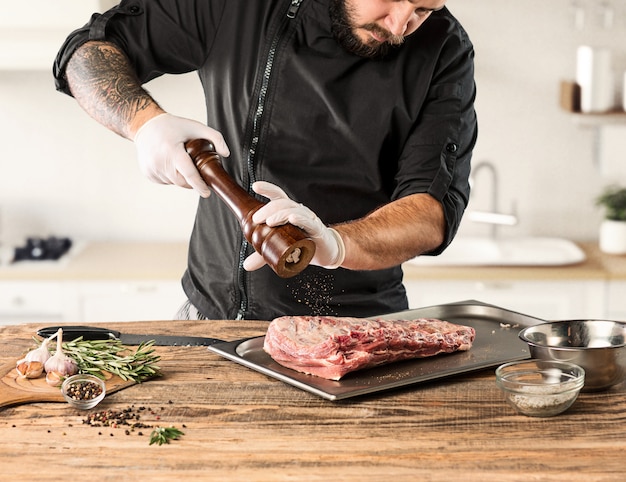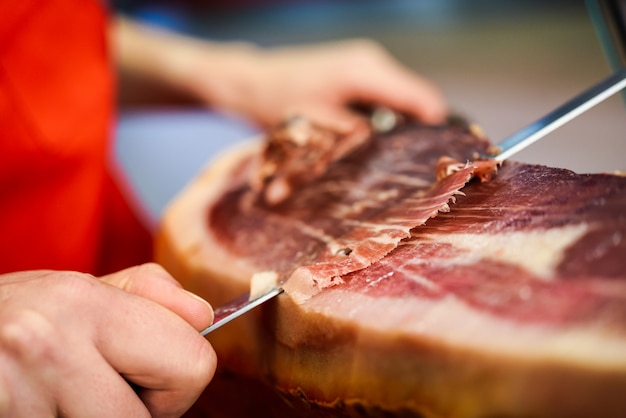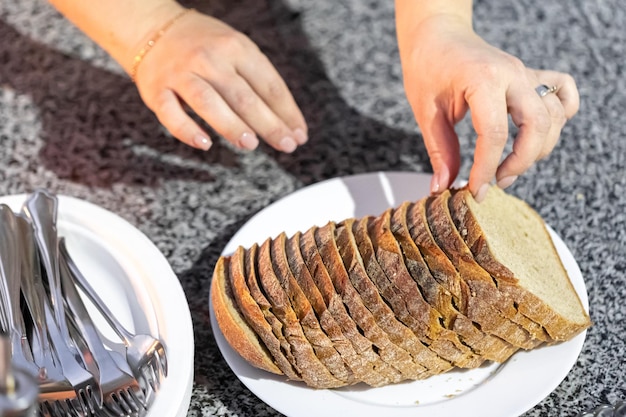You’ve got your hands on a beautiful piece of brisket, and you're ready to embark on a culinary adventure. You’ve heard tales of juicy, melt-in-your-mouth brisket, but the whole process can seem a bit intimidating. Don’t worry, my friend, I’m here to help! I’ve spent years perfecting my brisket technique, and I’m going to share all my secrets with you, from choosing the right cut to mastering the art of low-and-slow cooking.
This guide is more than just a recipe; it's a journey into the heart of brisket cooking. We’ll explore the science behind brisket's tenderness, delve into different cooking methods, and I'll share some of my personal tips and tricks that I've picked up along the way. This isn't your average "cook it for 12 hours and hope for the best" guide. This is a full-fledged brisket masterclass, designed to turn you into a brisket wizard.
Part 1: The Brisket Breakdown – What Makes It So Special?

Brisket isn’t your average cut of meat. It’s a true workhorse, packed with flavour and capable of delivering incredible tenderness when cooked correctly. It's a cut that demands respect, but rewards you with a truly satisfying experience.
Understanding the Anatomy
Firstly, let's talk about the anatomy of a brisket. It's basically a big, flat muscle from the cow's chest. It's divided into two parts: the flat (also known as the point) and the deckle (also known as the flat). The flat is leaner and more uniform, while the deckle has more marbling, which translates to more flavour and juiciness. Think of it like this: the flat is the athlete, lean and toned, while the deckle is the gourmand, rich and indulgent.
The Science of Tenderness
Now, the magic of brisket tenderness lies in a process called collagen breakdown. Collagen is a tough protein found in connective tissues, and it's what gives brisket its initial chewiness. But when you cook brisket low and slow, the heat gradually breaks down those collagen strands, transforming them into gelatin. That's why a properly cooked brisket becomes incredibly tender, almost melting in your mouth. It's a transformation that's both fascinating and delicious.
Choosing the Right Cut
Here’s the thing: not all briskets are created equal. You want to look for a brisket with good marbling, which means it has a decent amount of fat throughout the muscle. That fat is essential for flavour and tenderness. It's like a built-in flavour enhancer and moisture booster! A good brisket should also have a nice, even layer of fat on the top, which will help to keep the meat moist during cooking. Think of it as a natural shield against dryness.
Part 2: Preparing for the Brisket Odyssey

Alright, now that you’ve chosen your brisket, it’s time to prep for the big event. This step is crucial, as it lays the foundation for your brisket’s success. This is where we get to unleash our inner culinary artist.
Trimming the Fat
Before you get cooking, you’ll need to trim the brisket. This means removing any excess fat, leaving a nice, even layer on the top. I like to leave about 1/4 inch of fat on the top to help keep the meat moist. It's like giving your brisket a little protective layer of fat love.
Seasoning with Finesse
Now, the fun part! You can season your brisket any way you like, but I recommend a simple salt and pepper rub. This allows the natural flavour of the brisket to shine through. I also like to add a little bit of garlic powder, onion powder, and paprika for extra depth of flavour. Think of it as a subtle symphony of flavours, harmonizing with the natural essence of the brisket.
Part 3: The Low and Slow Approach – A Symphony of Time and Temperature

Here comes the crux of the brisket game: low and slow cooking. This is where patience and precision come into play. We’re talking about a long, slow process that transforms your brisket into a culinary masterpiece. It's like nurturing a delicate flower, allowing it to bloom slowly and beautifully.
The Low and Slow Mantra
Low and slow cooking means cooking your brisket at a low temperature (around 225-250°F / 107-121°C) for several hours. This allows the collagen to break down properly and the meat to become incredibly tender. It's a gentle dance between heat and time, resulting in a symphony of tenderness.
The Smoking Ritual
I’m a big fan of smoking briskets. The smoke adds a beautiful depth of flavour that elevates the entire experience. For smoking, you can use a wood smoker or a gas grill with a smoker box. I prefer hickory or mesquite wood for its earthy, smoky flavour. It's like a smoky embrace, adding a layer of complexity and intrigue to your brisket.
The Oven Alternative
Not everyone has a smoker, and that’s perfectly fine. You can still cook a fantastic brisket in the oven. Simply place the brisket on a roasting rack in a large roasting pan and cook it at a low temperature for several hours. Make sure to add a couple of cups of water to the bottom of the pan to create steam and keep the brisket moist. Think of it as a gentle steam bath, keeping the brisket plump and juicy.
Part 4: The Waiting Game – Mastering the Stall
Ah, the brisket stall, a phenomenon that every brisket cook encounters at some point. It's a temporary plateau in the cooking process where the internal temperature of the brisket seems to refuse to rise. But don’t panic! It's a natural part of the process.
The Science Behind the Stall
The stall occurs because of the evaporation of moisture from the brisket. As the brisket cooks, the surface becomes drier, which slows down the heat transfer. This can create a plateau in the internal temperature for several hours. It's like a little pause in the cooking journey, giving the brisket time to catch its breath.
Overcoming the Stall
There are a few ways to overcome the stall. One is to wrap the brisket in foil or butcher paper. This traps in moisture and helps to accelerate the cooking process. Think of it like a cozy blanket, keeping the brisket warm and moist. Another option is to increase the temperature slightly. I usually bump it up to 275°F / 135°C for an hour or two to help break through the stall. It's like a little nudge to get the brisket moving again.
Part 5: The Art of Resting – Allowing Flavours to Mingle
You’ve worked hard, your brisket has been cooking for hours, and you’re finally ready to taste the fruits of your labour. But hold on, there’s one more crucial step: resting.
The Importance of Rest
Resting allows the brisket to redistribute its juices and become even more tender. It also helps to even out the temperature throughout the brisket. I recommend resting your brisket for at least two hours, wrapped in foil or butcher paper, before slicing. It's like a little spa treatment for your brisket, allowing the flavours to relax and mingle, resulting in a more harmonious experience.
Part 6: The Moment of Truth – Slicing and Serving
This is the moment you’ve been waiting for. All those hours of work are about to pay off. Get ready to experience the magic of perfectly cooked brisket.
Slicing with Precision
Slice your brisket against the grain, which means slicing across the direction of the muscle fibres. This results in more tender, easier-to-chew slices. You can slice the brisket thin or thick, depending on your preference. It's like a delicate dance, respecting the natural structure of the brisket for maximum tenderness.
Serving with Style
There are so many ways to enjoy brisket. I love serving it on a bed of creamy mashed potatoes, with a side of tangy coleslaw and a rich gravy. You can also use it in sandwiches, tacos, or even salads. It's a versatile canvas, ready to be transformed into a culinary masterpiece.
Part 7: The Brisket Leftover Symphony
Okay, you’ve had your fill of delicious brisket, and you’ve got some leftovers. Don’t let those precious scraps go to waste! There are endless possibilities for leftover brisket.
Recreating the Magic
You can reheat your leftover brisket in the oven or on the stovetop. I like to add a little bit of broth or water to keep it moist. You can also shred the brisket and use it in a variety of dishes. Think of it as a second act, where the brisket gets to shine in new and exciting ways.
Leftover Inspirations
Here are a few of my favourite ways to use leftover brisket:
- Brisket sandwiches: Pile high with shredded brisket, cheese, and your favourite toppings. It's a classic for a reason, a sandwich that's both comforting and satisfying.
- Brisket tacos: A classic comfort food, brisket tacos are perfect for a quick and satisfying meal. A little bit of smoky magic wrapped in a tortilla.
- Brisket chili: Use leftover brisket to add a hearty and flavorful twist to your chili. A warm hug in a bowl, perfect for a chilly evening.
- Brisket mac and cheese: Take mac and cheese to the next level with shredded brisket and a creamy sauce. A decadent delight, a fusion of comfort food classics.
Part 8: The Brisket Chronicles – Lessons Learned
Over the years, I’ve learned a lot about brisket cooking. Here are a few key takeaways that have helped me consistently achieve amazing results:
Patience is Key
Brisket cooking is all about patience. Don’t rush the process. Allow the brisket to cook slowly and evenly. The time and effort will be worth it in the end. It's a slow burn that leads to an incredible reward.
Temperature is King
Maintaining a consistent cooking temperature is crucial for successful brisket. Use a good quality meat thermometer to monitor the internal temperature of the brisket and adjust the heat as needed. Think of it as a guardian angel for your brisket, ensuring it cooks perfectly.
Don’t Be Afraid to Experiment
Brisket cooking is an art form. Don’t be afraid to experiment with different seasonings, cooking methods, and even wood types if you’re smoking. Find what works best for you and your taste buds. It's like a culinary adventure, where you get to discover your own signature brisket style.
Embrace the Imperfections
Even the most experienced brisket cooks make mistakes sometimes. Don't be discouraged if your brisket doesn’t turn out perfectly. It’s all part of the learning process. Keep practicing, and you’ll eventually become a brisket master. Think of it as a journey of discovery, where every attempt brings you closer to your perfect brisket.
Part 9: FAQs: Brisket Wisdom Unveiled
I get a lot of questions about brisket cooking, so here are a few of the most common ones, along with my insights:
FAQs
| Question | Answer |
|---|---|
| How long should I cook a brisket? | The cooking time for a brisket can vary depending on the size and weight of the cut, as well as the cooking method. Generally, you can expect to cook a brisket for at least 10-12 hours, but some can take as long as 16-18 hours. Keep in mind that the internal temperature of the brisket should reach at least 203°F / 95°C for it to be considered safe to eat. It's like a marathon of cooking, but the finish line is worth the journey. |
| How do I know when my brisket is done? | The best way to tell if your brisket is done is to use a meat thermometer. The internal temperature should reach at least 203°F / 95°C. Another sign that your brisket is done is that it will be very tender and will easily pull apart with a fork. It's like a culinary test, ensuring your brisket has reached peak tenderness. |
| What should I do if my brisket is too tough? | If your brisket is too tough, it’s likely because it wasn’t cooked long enough at a low enough temperature. The collagen didn’t have enough time to break down properly. The good news is that you can still salvage your brisket. You can try braising it in liquid for a few hours to soften it. Think of it as a second chance for your brisket, allowing it to achieve its full potential. |
| What is the best way to reheat leftover brisket? | You can reheat leftover brisket in the oven or on the stovetop. I like to add a little bit of broth or water to keep it moist. You can also shred the brisket and use it in a variety of dishes. It's like giving your brisket a little refresh, keeping it flavorful and moist. |
| What are some good side dishes to serve with brisket? | Brisket pairs well with a variety of side dishes, including mashed potatoes, baked beans, coleslaw, cornbread, and macaroni and cheese. Get creative and experiment with different combinations to find your favourites. Think of it as a culinary symphony, where each side dish adds its own unique note to the overall experience. |
So there you have it, my comprehensive guide to brisket cooking. Remember, it’s all about patience, precision, and a bit of love. Go forth and conquer the art of brisket, and let me know how it goes. Happy cooking!
Everyone is watching

Corn on the Cob: The Ultimate Guide to Perfectly Cooked Ears
Healthy MealsAh, corn on the cob. Just the name evokes images of sunny days, barbecues, and that sweet, juicy flavour that ...

Perfect Pork Roast Oven Cooking Time: A Guide to Delicious Results
Healthy MealsThere's something truly satisfying about a perfectly roasted pork. The aroma alone is enough to make your mout...

Ham Cooking Time: How Long to Bake, Smoke, or Boil a Delicious Ham
Healthy MealsAh, ham. It's a classic, isn't it? A real crowd-pleaser, especially around holidays. And when done right, it'...

Scallops: The Ultimate Guide to Perfect Cooking
Healthy MealsAh, scallops. Those delicate, sweet, and utterly delicious morsels of the sea. They hold a special place in my...

Spaghetti Squash: The Ultimate Guide to Cooking and Serving
Healthy MealsRemember that time you saw spaghetti squash at the supermarket, looking all bumpy and strange, and thought, "W...
